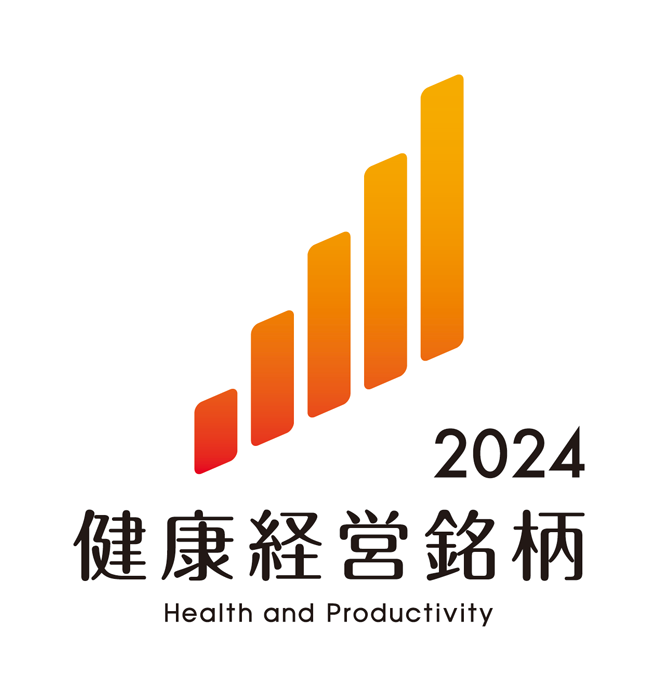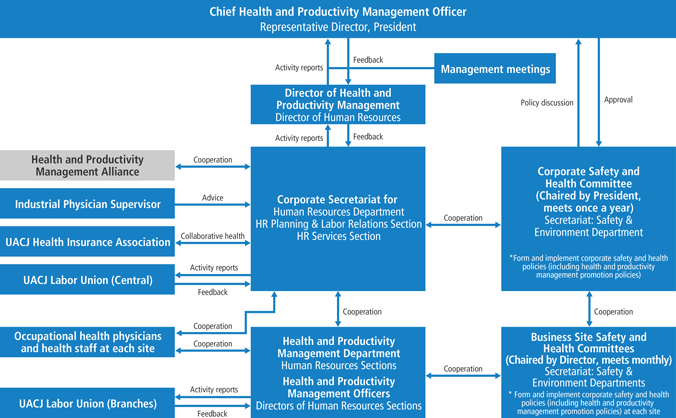Health and Productivity Management
Health and Productivity Management Policy
Basic Approach
The UACJ Group conducts safety and health activities based on the view that the safety, hygiene, and health of employees take precedence over everything else. Based on our conviction that preserving and promoting employee health is vital to the Group’s ongoing development, we announced our Health Management Policy in 2021 and our commitment to actively implement measures to promote employee health. The establishment of this implementation framework and the adoption of various measures have been highly acclaimed, and for our proactive health promotion and management efforts, we were recognized in the large enterprise category of the KENKO Investment for Health (KIH) program for two years running in fiscal 2022 and 2023. Furthermore, in 2024, we were selected as one of the “KENKO Investment for Health Stocks,” which is given to listed companies that excel in health management, and also selected as one of the “Certified Health & Productivity Management Outstanding Organizations ‘White 500,’” which is awarded to only the top 500 certified companies in the large enterprise category.


The UACJ Group Health and Productivity Management Policy
The UACJ Group recognizes that the sound health of its employees is a foundation for sustainable business activities. Accordingly, it aims to contribute to a better world as a group of companies in which all employees can perform their jobs actively and productively. Toward this end, the UACJ Group shall make efforts to raise awareness of health among its employees and their family members, and help employees maintain and improve their physical and mental health so that they can proactively prevent illness and lead healthy lives.
Health and Productivity Management Promotion Structure
In accordance with the UACJ Group Health and Productivity Management Policy, the Group endeavors to maintain and promote employee health following the management structure presented below. The Safety and Health Committee, comprised of all executive officers and chaired by the president, discuss activities, issues, and programs related to employee health and safety.

Health and Productivity Management Issues
The UACJ Group believes we cannot expect to achieve continuing growth as a company if employees chronically take long absences or leave due to physical or mental illness (absenteeism) or if employees who are present are unable to fully function due to health reasons (presenteeism). The UACJ Group aims to minimize absenteeism and presenteeism and increase employee engagement by being a company where employees can work with enthusiasm and vitality and that is attractive to diverse human resources.
We also believe that our health and productivity management initiatives will enhance the performance of both individual employees and our organization, which together will lead to the fulfillment of the UACJ Group Vision “Harnessing aluminum to reduce the impact on the environment and build a better world.”
Health Targets
- Reduce absenteeism (2.0 or fewer employees by FY2027, target set based on the current status and recommendation of occupational health physicians)
- Reduce presenteeism (achieve the global average of 91.7% by FY2027)
- Increase engagement (above 3.34 points by FY2024, the average score for large corporations)
- Note1 Absenteeism is the number of employees per 100 employees who have long absences or leaves: 3,201 employees, coverage 100%
- Note2 Presenteeism is a comprehensive evaluation of work functioning impairment scale (WFun): 3,124 employees, response rate 94.9%.
- Note3 Engagement is a comprehensive 5-point scale index of the organizational activation survey of Nikkei Research Inc.: 2,926 employees, response rate: 92.6%
Company Health Issues and Improvement Targets
| Company Health Issues | Specific Improvement Targets |
|---|---|
| Reduce risk of lifestyle diseases | 60% of employees with an appropriate weight |
| Reduce the percentage of employees who smoke | Under 30% employees who smoke |
| Reduce long-term absenteeism and leave of absence due to mental health conditions | Under 1% employees taking long absence and leave due to mental health conditions |
| Reduce employees with monthly overtime exceeding 45 hours | Less than 1 for the average number of employees that has exceeded 45 hours of overtime in a year |
| Increase employee engagement | 80% of employees reporting increased engagement |
| Raise employee health awareness | 100% viewership of health seminar videos |
Health Maintenance and Improvement Initiatives
Reduce Risk of Lifestyle Diseases
Our objective is 100% participation in the regularly scheduled employee health checkups. We also encourage employees to follow up the checkup results and industrial physician recommendations with reexaminations or more detailed examinations, for which we aim for a 90% participation rate. We also cooperate with the health insurance association to encourage employees to follow specific health guidance. In fiscal 2024, the association director and the general managers of each business site issued a joint recommendation for all eligible employees receive medical examinations. To encourage a positive approach to following the health guidance, we have increased the number of courses in the Lifestyle Guidance Improvement Program and made it optional with the aim of over half of employees to be following their health guidance. To encourage employees to pursue the health benefits of walking, in fiscal 2024 we introduced a system that awards health points based on the monthly average number of steps taken. The objective of these and other measures is for at least 60% of employees maintaining an appropriate body weight.
Reduce the Percentage of Employees who Smoke
We began eliminating indoor smoking areas and reducing the number of designated smoking areas when Japan adopted the revised Health Promotion Act in 2018. We also worked with the health insurance association to free smoking cessation treatment for employees wishing to quit smoking. In addition, to offer more options and make it easier for people wanting to quit, in 2023 we began providing a program led by a company specializing in helping people quit smoking. Other measures to encourage employees to quit smoking include all of our business sites observing the World No Tobacco Day, no tobacco days on the 22nd of each month, and presentations by occupational health physicians on the health hazards of smoking arranged by the Health and Safety Committee.
Reduce Long-term Absenteeism and Leave of Absence Due to Mental Health Conditions
We conduct workplace stress checks to help employees be aware of their level of stress and encourage employees to consult with occupational health physicians and external organizations. In addition, in accordance with the mental health promotion plan of the Ministry of Health, Labour and Welfare, we seek to raise awareness of mental healthcare through programs on self-care for new employees and a system of superiors providing health guidance (line-care) for newly appointed managers and organizational managers, e-learning on self-care and line-care, presentations by occupational health physicians arranged by the Safety and Health Committee. We also maintain a leave management system and help employees seeking to return to work after taking a leave of absence for a mental health issue, assist with rework (return to work), and provide vocational rehabilitation.
Reduce Employees with Monthly Overtime Exceeding 45 Hours
The personnel plans we formulate for each fiscal year seek to secure an adequate number of personnel through the hiring at each business site of new college graduates and mid-career professionals, including actively recruiting women and older workers, while taking into account our drives to reduce employee overtime and encourage the full use of employee leave time. We conduct measures to foster employee awareness of overtime work by instituting efforts to turn off lights at 8 p.m., requiring work notifications to be submitted when planning to work late at night or on a non-business day, designated specific “no overtime” days, instructing employees on work hour management, and having supervisors in attendance when an employee is regularly consulting an occupational health physician. These efforts have had a certain degree of success reducing the number of employees who put in large amounts of overtime work.
In fiscal 2021, we institutionalized telecommuting, which was first introduced as a preventive measure at the start of the COVID-19 pandemic in fiscal 2020. Our telecommuting model accommodates working at both the office and at home (or, upon discretion of the division manager, working full-time at home). This model improves the work-life balance of employees, such as by eliminating commute time, and is also contributing to greater employee engagement.
Increase Employee Engagement
In fiscal 2020, we began conducting annual engagement surveys of all UACJ Group company employees to identify indicators of overall job satisfaction and motivation and factors that influence those indicators (assessments of personal motivation, workplace vitality, the personnel systems, and top management). The survey results are used as the basis for measures to improve engagement at all levels, such as holding discussion meetings between employees and management, improving the personnel systems of the Human Resources Department, and introducing reform measures for specific work places. We also present popular seminars on work and communication techniques that help improve engagement and productivity. We also support health and productivity management of our supply chain by opening the seminars to employees of partner companies working in our offices.
Raise Employee Health Awareness
We believe that increasing employee health literacy and awareness are essential to successful health and productivity management, and in fiscal 2023 began distributing about three short, three- to four-minute videos each month for employees to watch about maintaining and improving personal health. We encourage employees to watch the videos during work hours, work breaks, or during their free time and also recommend watching all together as a group so they will exchange comments and stimulate communication. We also take various steps to increase viewership, such as by announcements in the internal newsletter, mentions at labor union delegate meetings messages, showing them on monitors in the plant cafeterias and offices, mandating viewing prior to regular health examinations, requesting they be part of organizational programs, and showing and discussion them at meetings of the Health and Safety Committee.
Spending Health and Productivity Management Measures (per year, yen in thousands)
(*UACJ Corporation)
| FY2019 | FY2020 | FY2021 | FY2022 | FY2023 | |
|---|---|---|---|---|---|
| Lifestyle diseases | 21,403 | 20,989 | 21,501 | 25,832 | 27,750 |
| Smoking cessation | 0 | 20 | 52 | 0 | 243 |
| Mental health | 4,602 | 4,903 | 4,652 | 4,548 | 6,278 |
| Long working hours | 83,220 | 63,738 | 68,977 | 127,534 | 137,586 |
| Engagement | 29,800 | 20,070 | 15,720 | 17,320 | 17,970 |
Health Initiative Progress Indicators
| FY2019 | FY2020 | FY2021 | FY2022 | FY2023 | |
|---|---|---|---|---|---|
| Percentage of employees receiving regular health examinations | 100% | 100% | 100% | 100% | 100% |
| Percentage of employees receiving comprehensive examinations | - | - | 48.9% | 73.4% | 86.3% |
| Percentage of employees participating in stress checks | 94.0% | 94.3% | 90.9% | 91.7% | 95.4% |
| Percentage of employees receiving recommendations for high-risk health issues | - | - | - | 76.4% | 100% |
| Percentage of employees receiving recommendations for specific health issues | 7.7% | 11.0% | 13.4% | 22.1% | 19.4% |
| Percentage of managers viewing videos on women’s health promotion | - | - | - | 100% | 100% |
| Number of No Tobacco Days | 16 | 28 | 28 | 28 | 40 |
| Number of people participating in smoking cessation programs | 0 | 1 | 3 | 0 | 5 |
| Employee satisfaction with health measures | - | - | - | 3.07 | 3.25 |
| Number of participants in engagement seminars | - | - | 71 | 214 | 242 |
| Engagement survey response rate | - | 81.5% | 80.0% | 80.0% | 92.6% |
| Percentage of employees reporting increased engagement | - | - | 95.0% | 64.0% | 18.8% |
| Percentage of employees implementing engagement initiatives | - | - | 57.0% | 63.5% | 80.0% |
| Annual incidence of an employee working more than 45 hours of overtime in a month | 51.4% | 59.6% | 112.0% | 53.5% | 52.7% |
| Percentage of paid leave taken | 65.4% | 53.8% | 62.0% | 69.0% | 65.6% |
Employee Awareness and Behavioral Change Indicators
(*UACJ Corporation)
| FY2019 | FY2020 | FY2021 | FY2022 | FY2023 | |
|---|---|---|---|---|---|
| Percentage of employees maintaining appropriate bodyweight | 53.7% | 57.8% | 62.0% | 60.8% | 61.1% |
| Percentage of employees who regularly exercise | 9.5% | 9.9% | 23.0% | 23.7% | 24.1% |
| Percentage of employees who smoke | 38.2% | 37.7% | 35.3% | 34.3% | 34.3% |
| Percentage of high-risk employees taking oral medication | - | - | - | 62.9% | 25.6% |
| Percentage of employees viewing health and productivity management videos | - | - | 3.4% | 27.7% | 99.1% |
Health Indicator Targets
| FY2019 | FY2020 | FY2021 | FY2022 | FY2023 | |
|---|---|---|---|---|---|
| Absenteeism | 2.87 | 2.16 | 2.63 | 1.71 | 2.44 |
| Presenteeism | - | - | - | - | 90.9% *1 |
| Engagement | - | 3.26 | 3.27 | 3.28 | 3.3 |
| Percentage of employees taking extended absence and leave for reasons other than mental health | 0.8% | 0.67% | 1.22% | 0.64% | 0.60% |
| Percentage of employees taking extended absence and leave for mental health reasons | 1.92% | 1.58% | 1.60% | 1.07% | 2.00% |
| Percentage of employees with high stress check scores | 15.2% | 14.7% | 15.7% | 18.7% | 18.5% |
| Employee turnover rate for personal reasons | 3.1% | 2.8% | 3.1% | 3.1% | 3.7% |
Commentary: Absenteeism increased from fiscal 2022. On the physical side, working with the health insurance association and others to new create health services has steadily increased the percentage of employees regularly exercising and lowered the amount of smoking. We will continue trying to improve the health performance through the health points, specific health guidance, online smoking cessation program, and other measures. Mental health support will continue by encouraging employees to take stress checks, engaging the mental health promotion plan providing education on self-care and management’s role supporting employee mental health, and taking further steps to ensure all employees are aware of the new external Employee Assistance Program contact points introduced in fiscal 2024. Based on the belief that increased health awareness is the key to a healthy workforce, we actively disseminate information through the monthly health videos and by showing the videos on monitors in the venues for the health checkups, cafeteria, and other locations where employees will naturally be inclined to watch. These efforts are producing steady improvement in employee engagement. Discussion meetings, seminars, and other events are held to support voluntary efforts in the workplace. Outstanding health initiatives are honored with the president’s award and are shared throughout the organization. The assessment of presenteeism begun in fiscal 2023 will continue and employees will be encouraged to consult with industrial physicians.
*1 FY2024 90.9%

